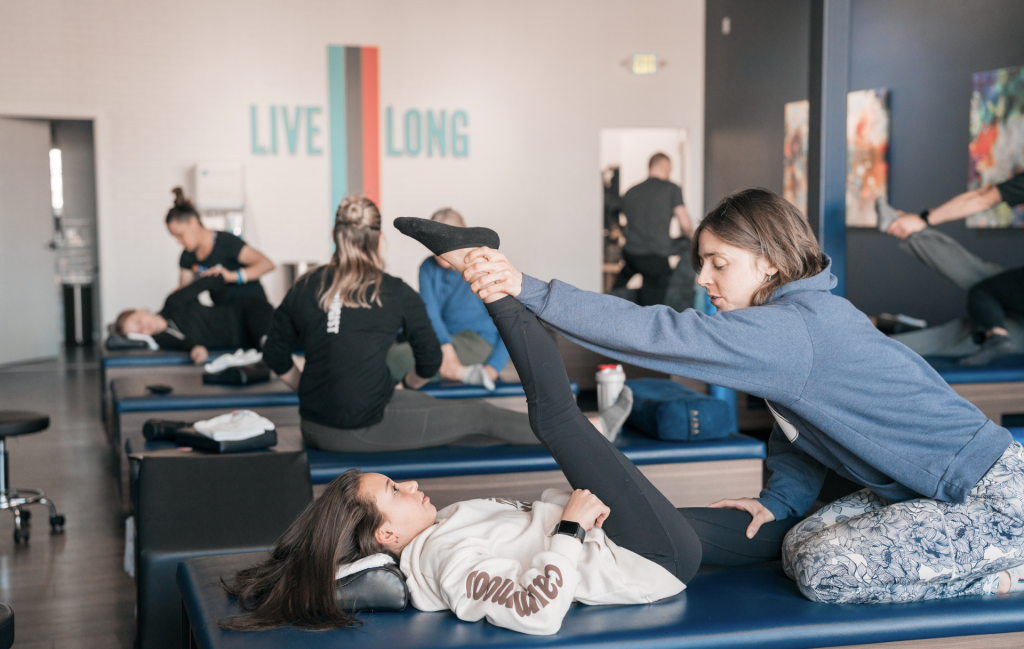Intentional stretching increases circulation, reduces stress and boosts mental clarity
By Jamie Lynn Miller
Photography Courtesy of StretchLab
There are myriad benefits to a regular stretching practice, from looser muscles to increased circulation and a notable reduction in stress. And yet, from dedicated athlete to casual walker, carving out time and space to properly stretch rarely tops the to-do list.
“When people have limitations in their movement, it can definitely impede the lifestyle they want to live,” says Andrea Schott, of StretchLab Cherry Creek, where assisted stretching activates the science of loosening up.
Stretching oxygenates the body, optimizes blood flow and boosts overall energy. As limbs loosen, so too does tightness in body and mind. In terms of general injury prevention, target the areas of the body most needed for mobility: hamstrings, calves, hip flexors, pelvis and quads. Remember to move that neck side to side, and twist at the waist to warm up your torso.

Some types of stretches are a slow, prolonged burn—the longer the hold, the greater the benefit.
“Yin yoga–type stretches help release physical tension,” says Heather Ardley, a contract physical therapist who helps patients across the Front Range. “When the fascia, or connective tissue, is strengthened, the results are phenomenal.”
Also known as low-load, long-duration stretching—holding a stretch for more than one to two minutes—yin-type stretches yield big results.
“When you’re holding in that passive position, it’s very therapeutic,” Ardley says.

FOR YIN-YOGA, TRY:
BUTTERFLY POSE: This is a good example
of yin-like stretching. Sit on the ground with knees wide open, soles of the feet pressed together. Hold and breathe into the pose, pressing lightly onto the legs to further the sensation.
For pre-workout routines, dynamic stretches help the body warm up for increased activity. By heating up the muscles and decreasing stiffness, dynamic stretches ramp up the body for increased movement. Mainstay dynamic stretches include arm circles and lunges.
FOR DYNAMIC, TRY:
ARM CIRCLES: Start with feet shoulder-width apart, arms in a T perpendicular to the body. Rotate straightened arms in small, focused circles. Increase circle size, forward and back, to loosen up the triceps. Try two rounds of 10 rotations as a base layer routine.
LUNGES: Tighten the core and take a large step forward with either leg. Bend that leg—thigh parallel to the floor, shin vertical—and sink your weight into your heel. Hold; feel the goodness; switch legs.
In contrast, post-workout stretches are static. Static stretches are held for up to a minute, moving the body toward stillness and easing tired muscles. Try these more stationary stresses to decompress after a good workout:
FOR STATIC, TRY:
TOE TOUCHES: Start with legs straight, toes forward and feet a few inches apart. Activating the core, bend from the hips and try to touch your toes. Continue to find that length for 30 to 60 seconds.
HAMSTRING STRETCH: Sit on the floor with your legs straight in front of you, then work your hands toward the toes. Go as far down as possible (the burning sensation will show you your limit) and hold for 30 seconds The hamstring stretch is a mainstay of injury prevention, as it keeps the anterior leg muscles limber.
To augment your practice and access hard-to-reach muscles, many turn to assisted stretching facilities. Moving through an initial sequence to determine tightness and asymmetry, StretchLab’s flexologists can develop a personalized plan for each client’s alignment.
“No two bodies are the same,” Schott says. “Each individual needs specific attention.”

STRETCHLAB CHERRY CREEK
3201 E. 2nd Ave., Ste. 103
Denver
720.464.6333
stretchlab.com/location/cherrycreek
TIPS FOR OVERALL HEALTH AND MOVEMENT:
• MOVE YOUR BODY on
a daily basis, whether it’s stretching, cardio, strength training or a gentle walk. Daily movement helps with overall health maintenance.
• STAND-UP DESKS are a great way to maximize computer time. Otherwise, break up long periods of sitting with a walk around the block or through your office space.
• STAY HYDRATED! Proper hydration improves overall health, from digestion to energy boosts to helping with allergies. Shoot for at least 8 glasses a day (64 ounces of water) to benefit your body and brain.


